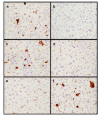Improved management of lysosomal glucosylceramide levels in a mouse model of type 1 Gaucher disease using enzyme and substrate reduction therapy
- PMID: 20336375
- PMCID: PMC3683842
- DOI: 10.1007/s10545-010-9072-z
Improved management of lysosomal glucosylceramide levels in a mouse model of type 1 Gaucher disease using enzyme and substrate reduction therapy
Abstract
Gaucher disease is caused by a deficiency of the lysosomal enzyme glucocerebrosidase (acid beta-glucosidase), with consequent cellular accumulation of glucosylceramide (GL-1). The disease is managed by intravenous administrations of recombinant glucocerebrosidase (imiglucerase), although symptomatic patients with mild to moderate type 1 Gaucher disease for whom enzyme replacement therapy (ERT) is not an option may also be treated by substrate reduction therapy (SRT) with miglustat. To determine whether the sequential use of both ERT and SRT may provide additional benefits, we compared the relative pharmacodynamic efficacies of separate and sequential therapies in a murine model of Gaucher disease (D409V/null). As expected, ERT with recombinant glucocerebrosidase was effective in reducing the burden of GL-1 storage in the liver, spleen, and lung of 3-month-old Gaucher mice. SRT using a novel inhibitor of glucosylceramide synthase (Genz-112638) was also effective, albeit to a lesser degree than ERT. Animals administered recombinant glucocerebrosidase and then Genz-112638 showed the lowest levels of GL-1 in all the visceral organs and a reduced number of Gaucher cells in the liver. This was likely because the additional deployment of SRT following enzyme therapy slowed the rate of reaccumulation of GL-1 in the affected organs. Hence, in patients whose disease has been stabilized by intravenously administered recombinant glucocerebrosidase, orally administered SRT with Genz-112638 could potentially be used as a convenient maintenance therapy. In patients naïve to treatment, ERT followed by SRT could potentially accelerate clearance of the offending substrate.
Figures






Similar articles
-
Substrate reduction augments the efficacy of enzyme therapy in a mouse model of Fabry disease.PLoS One. 2010 Nov 24;5(11):e15033. doi: 10.1371/journal.pone.0015033. PLoS One. 2010. PMID: 21124789 Free PMC article.
-
A specific and potent inhibitor of glucosylceramide synthase for substrate inhibition therapy of Gaucher disease.Mol Genet Metab. 2007 Jul;91(3):259-67. doi: 10.1016/j.ymgme.2007.04.001. Epub 2007 May 16. Mol Genet Metab. 2007. PMID: 17509920
-
AAV8-mediated expression of glucocerebrosidase ameliorates the storage pathology in the visceral organs of a mouse model of Gaucher disease.J Gene Med. 2006 Jun;8(6):719-29. doi: 10.1002/jgm.901. J Gene Med. 2006. PMID: 16528760
-
Gaucher disease and its treatment options.Ann Pharmacother. 2013 Sep;47(9):1182-93. doi: 10.1177/1060028013500469. Ann Pharmacother. 2013. PMID: 24259734 Review.
-
Velaglucerase alfa, a human recombinant glucocerebrosidase enzyme replacement therapy for type 1 Gaucher disease.Curr Opin Investig Drugs. 2010 Apr;11(4):472-8. Curr Opin Investig Drugs. 2010. PMID: 20336596 Review.
Cited by
-
Lysosomal storage diseases: current therapies and future alternatives.J Mol Med (Berl). 2020 Jul;98(7):931-946. doi: 10.1007/s00109-020-01935-6. Epub 2020 Jun 11. J Mol Med (Berl). 2020. PMID: 32529345 Review.
-
Combination Therapies for Lysosomal Storage Diseases: A Complex Answer to a Simple Problem.Pediatr Endocrinol Rev. 2016 Jun;13 Suppl 1(Suppl 1):639-48. Pediatr Endocrinol Rev. 2016. PMID: 27491211 Free PMC article. Review.
-
CNS, lung, and lymph node involvement in Gaucher disease type 3 after 11 years of therapy: clinical, histopathologic, and biochemical findings.Mol Genet Metab. 2015 Feb;114(2):233-241. doi: 10.1016/j.ymgme.2014.08.011. Epub 2014 Sep 2. Mol Genet Metab. 2015. PMID: 25219293 Free PMC article.
-
Are Glucosylceramide-Related Sphingolipids Involved in the Increased Risk for Cancer in Gaucher Disease Patients? Review and Hypotheses.Cancers (Basel). 2020 Feb 18;12(2):475. doi: 10.3390/cancers12020475. Cancers (Basel). 2020. PMID: 32085512 Free PMC article. Review.
-
Respiratory manifestations in patients with inherited metabolic diseases.Eur Respir Rev. 2013 Dec;22(130):437-53. doi: 10.1183/09059180.00008012. Eur Respir Rev. 2013. PMID: 24293461 Free PMC article. Review.
References
-
- Beutler E, Grabowski GA. Gaucher disease. In: Beaudet AL, Sly WS, Valle D, editors. The metabolic and molecular basis of inherited disease (Scriver CR) McGraw-Hill; New York: 2001. pp. 3635–3668.
-
- Charrow J, Andersson HC, Kaplan P, et al. Enzyme replacement therapy and monitoring for children with type 1 Gaucher disease: consensus recommendations. J Pediatr. 2004;144:112–120. - PubMed
-
- Cox TM, Aerts JM, Andria G, et al. The role of the iminosugar N-butyldeoxynojirimycin (miglustat) in the management of type 1 (non-neuropathic) Gaucher disease: a position statement. J Inherit Metab Dis. 2003;26:513–526. - PubMed
MeSH terms
Substances
Grants and funding
LinkOut - more resources
Full Text Sources
Other Literature Sources
Medical
Research Materials

